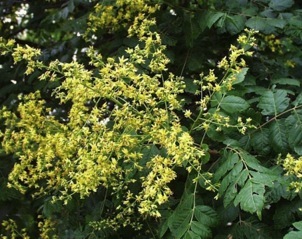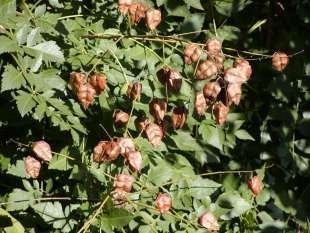Showers of Golden Rain Tree
The scallions didn’t have a chance.
My Taiwanese friend liked to grow scallions in a postage stamp garden in her back yard. They added fresh flavor to her down-home Chinese cooking. But her neighbor had a Golden Rain Tree that loomed over the scallion patch like an ominous shadow. In the fall it was constantly showering her garden with seed capsules, producing hundreds of sprout seasonally. The tree eventually won. Unfortunately this was a quarter of a century before I knew those Golden Rain Tree shoots were edible. You must, however, have the right species.
This particular Golden Rain Tree was a Koelreuteria paniculata (kole-roo-TEER-ee-uh pan-ick-yoo-LAY-tuh) a native of China and Japan. It was named for Joseph Gottlieb Kolreuter, 1733-1806, who carried out experiments in hybridization and published research about tobacco. He was noted for two things; his ingenious experiments and his complaint that professors of botany didn’t make much money. My German isn’t that good but I think Koelreuter can mean “cabbage patch” or “cabbage thief.”
Besides eating tender young shoots and leaves (boiled) the yellow flowers produce a yellow dye and an eye wash. The mature leaves produce a black dye. As for eating the seeds… all reports say they are roasted but acidic, which makes sense as they have the same irritating oil found in unrefined canola oil (which if I remember correctly is erucic acid.) Their the seeds also might be insecticidal. By most accounts the roasted seeds are a famine food. I have not tried them. They’re on my list of things to do when I have better health insurance. The leaves and shoots have some antioxidant and anti-tumor “activity” but also have some traces of cyanide, hence the cooking. These are not for raw salads.
The Golden Rain Tree was introduced to the west from China by Jesuit missionary, Pierre d’Incarville in 1747. The trees were under cultivation in Jardin du Roi by 1763. The tree reached America by 1809 when Thomas Jefferson germinated seeds sent to him by a French friend. While it has since become a popular landscape tree worldwide it is also an invasive species in many places including Florida.
Green Deane’s “Itemized” Plant Profile
IDENTIFICATION: Trees or shrubs, deciduous, bark grayish brown to black, stout, fissured, lenticels gray to dark brown, small; branches tuberculate, appressed pubescent or glabrous with axes and petioles. Leaves fascicled on young branches, spreading, pinnate, imperfectly bipinnate, or sometimes bipinnate, sessile or very shortly petiolate, opposite or alternate, ovate or broadly ovate to ovate-lanceolate, sometimes hairy or densely pale yellow pubescent. Flowers pale yellow, slightly fragrant, 4 petals
TIME OF YEAR: Locally it is in its ornamental glory in October.
ENVIRONMENT: Full sun, rich soil, will tolerate some variation.
METHOD OF PREPARATION: Boiled young shoots and leaves, roasted seeds… perhaps.
HERB BLURB
SUN Bao-teng et al (College of Life Science,Nanchang, University,Nanchang,Jiangxi 330031)
[Objective] The study aimed to analyze the oil content in seed kernel and the components of fatty acid in the seed oil of Koelreuteria bipinnata Var.integrifolia T.Chen.[Method] The seed oil of K. bipinnata was extracted with soxhlet extraction and the oil content in seeds was calculated. The component of fatty acid in seed oil was detected with gas chromatograph-mass spectrometer after the fatty acid being methyl esterified.[Result] The oil content in seed kernel of K. bipinnata reached 54.04%. There were 5 saturated fatty acids and 3 unsaturated fatty acids in seed oil,among which,the content of unsaturated fatty acid reached 75.26%,and the unsaturated fatty acid mainly contained oleic acid(31.07%), eicosenoic acid(35.07%) and erucic acid(9.12%). The nutrition value of seed oil of K. bipinnata was higher,but in which there were no polyunsaturated fatty acid with more higher nutrition value and there were erucic acid and arachidic acid that indigestible in the oil.[Conclusion] The seed oil of K. bipinnata had higher nutrition value, but whether it could be used as edible oil needs to make the toxicological study. (GREEN DEANE NOTE: Erucic acid is limited to 2% and 5% in Canada and Europe respectively in Canola Oil for food.)





Does it taste any good?
I am a student studying and living on campus at the University of Arkansas in Little Rock. I have been using your site to learn how to eat from the wild. I’m poor and we don’t have a meal plan during the summer, so Thank you so much! I forage every day. So far, my favorite wild green is pigweed! Anyway, I found a golden rain tree on campus, and I gathered a bunch of the pods, extracted the seeds, coated them with olive oil and salt, and roasted them at 300 degrees until they were very crispy. I did that because they were less bitter when they were almost burnt. I had about 1/2 cup of seeds. Even though I cooked them until crispy, they were too bitter for me to eat, so I wound up throwing them away. My throat still kind of feels weird from it. (I did this just tonight). Oh well, I tried.
I have been collecting the seeds from Goldenrain trees (Thanks for the help identifying it!). The seeds have a dark brown husk which I like to peel away as it seems to be the source of the bitterness that Esther tasted (I taste it too – I eat the seeds raw, though never more than about ten on any given day – look up mithriditization if you want to know more).
I have been puzzling over the best way to prepare these seeds because I like their nutty flavor. A minor reason is my… intuition … that they might help suppress my body’s tendency to over-produce platelets (“Essential Thrombocythemia”). I will roast them from now on, but only after removing the husk, which I usually do in a very inefficient manner, cutting off the end with the tiny stem and then either peeling away the rest of the husk or squeezing the insides out.
My latest plan (haven’t done it yet) is to crush the seeds before they get too dry. When they’re dry, crushing them will shatter the husk and thus mix tiny black pieces into the seed-mush, but if the husk isn’t too dry, it will yield to the crushing force, like squeezing toothpaste out of the tube. Maybe a garlic press will work.
I will then try cooking the seed mush in a few different ways.
I tried frying the seeds (still with their husks) once, and overcooked them. Like Esther, I found they were ok when almost-burnt. I thought they might pop like popcorn, and was hopeful when I heard some of the crack in the heat, but the insides don’t expand enough to shed the husk. I like the idea of removing the husks first, so that is my plan.
Please please tell me how to get the pods of this tree in USA. My son lives on this as his constipation/eosinophilic esophagiits medicine.
I get it form India but it is hard as we have to go there and get it.
PLEASE HELP!!
Shruti,
Did you get any seeds? I have some i can send you. Your post is five years old, though, and it would take time to grow the tree. I hope your son is doing well!
Shruti, Guessing on a long term solution. Try planting the seeds you get. You probably want the exact same variety. As an invasive you should be able to harvest it easily. Did not know what is was and just found a tree in NJ to see what it was.
Reading about this tree reminds me of a most wonderful book (and less wonderful movie). The book, by Ross Lockridge Jr, is “Raintree County” – and would be especially interesting to Hoosiers!
Hello Deane and everyone .
Thank you for the great information about this tree . It’s great to know it’s edible too .
I found a tree in Ilford , UK and got some seeds only for the great look .
I managed luckily to sprout one in a zip bag after a few weeks . It helps to cut the skin of the seed a bit .
Looking forward to try the sprouts in the near future .
All the best !
This tree does well in southwest New Mexico. The Koelreuteria paniculata is the same species I see throughout the Southwest but I never realized you could eat the seeds! I know it is an invasive species in places where there is a lot of rain but in the desert Southwest where rain is at a premium, it rarely happens. Thanks for this scientific study on these seeds.
In Tennessee the tree produces an abundance of sprouts. Maybe it is the rainfall we receive here. They thrive in the soil once they get started and I can understand why they would be on the invasive specie list. Beautiful tree, however.
The actual spelling of the name of the eponymous botanist is , with an o-umlaut. (Hence the spelling in the Latinised form, following mediaeval orthographical practice.) So it’s doubtful cabbage is involved. Moreover, the name is composed of + , i.e. “person from Kölreut”, and not * + .
“Kölreut” is most likely a variant form of , a small settlement near Berg in the far southeastern corner of Baden-Württemberg. The / element is common in German toponyms and means “clearing”. The first element is more obscure but may represent a form of “savory [i.e. plant of the genus Satureja]”. (Alternation between and is common in German dialects; even Goethe pronounced his own name with and not /.)